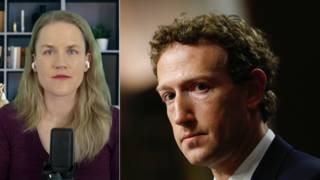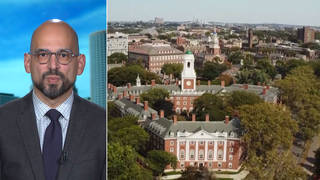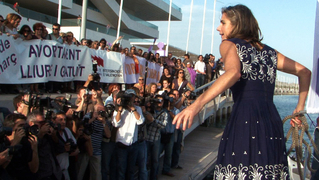
Guests
- Diana Whittendirector of the film Vessel. Learn more about the film at vesselthefilm.com.
In Part 2 of our interview, Diana Whitten, director of “Vessel,” talks about how Brazilian women first discovered the medication misoprostol could be used to induce abortion, and how Dr. Rebecca Gomperts and her team have helped women to take the pills safely in countries where abortion is illegal. “Vessel” documents the work of Gomperts, founder of Women on Waves, who set sail to provide abortions in international waters off the coast of countries where it is banned. Gomperts later founded Women on Web, an online service that helps women obtain and safely take pills to induce abortion. In this extended interview, Whitten also talks about the landscape of abortion restrictions in the United States. “When I originally conceived of the film, I thought it was going to be a foreign story, and what we’ve seen since is that the story has become local,” Whitten says. “Women here in the States, in many parts of the States, are experiencing the same reality as women living in countries where abortion is illegal.”
Click here to watch Part 1 of this discussion, which includes Dr. Rebecca Gomperts.
AMY GOODMAN: This is Democracy Now!, democracynow.org, The War and Peace Report. I’m Amy Goodman, with Nermeen Shaikh. Our guest is Diana Whitten, director of the film Vessel. The film talks—follows this group, led by Rebecca Gomperts, doctor from Amsterdam, who challenges country after country to make abortion legal, actually to provide abortion for women. In this case, they are using the pill to use—that acts as an abortifacient, induces abortion. Can you talk more about the pill that is used, or the pills?
DIANA WHITTEN: Sure. Here in the States, we use a two-pill regimen for abortions that are offered in clinics. So it’s a combination of mifepristone and misoprostol. And used together, they’re, I think, over 98 percent effective. The second pill, misoprostol, can be used alone to induce abortion. And in much of the world where abortion is illegal, women can find this pill over the counter and take it off-label to basically induce a miscarriage, induce an abortion.
AMY GOODMAN: And “off-label” means like it’s for ulcer or something?
DIANA WHITTEN: Exactly. Well, the pill is registered for—as an anti-gastric ulcer medication. So, “off-label” means you’re taking it for an indication that’s not—that it isn’t originally indicated for. So, women actually discovered this for themselves back in Brazil a couple decades ago by reading the labels on the pills, and when it said, “Don’t take it if you’re pregnant,” they thought, “Well, maybe if I want to end a pregnancy, this could help.” And it then became researched and sanctioned by the WHO and other scientists and medical professionals, and now it’s registered by the WHO as an essential medicine.
AMY GOODMAN: What percentage of abortions in the United States are surgical, and what percent are done—and I know you can’t talk about the ones that are unofficial, but in clinics, do you know how many more are used—are medical abortions, women just taking this pill, even at a clinic?
DIANA WHITTEN: I don’t actually know the numbers. I think someone from Planned Parenthood might be able to answer that more accurately.
AMY GOODMAN: I heard somewhere it’s something like a third are through the pill.
DIANA WHITTEN: Is it? Well, a lot of women opt for it, you know? What it offers is a chance to take care of the—to do the procedure in a private setting. I mean, a lot of women would prefer to go home and just deal with this. Miscarriage is something that women know how to deal with. And this pill gives them that option.
NERMEEN SHAIKH: Could you talk about the process of making the film? You worked on this for several years.
DIANA WHITTEN: For seven years, yeah.
NERMEEN SHAIKH: Seven years, yeah.
DIANA WHITTEN: Sure, yeah. Eight years ago, I was researching offshore spaces for an international studies program. I was getting my master’s, trying to shift away from film, because I had been working in the film world prior. And, of course, it turned into a film, so can’t get away. But at any rate, it was one of the first examples I had found of this offshore space, this offshore political or geopolitical construct, being occupied for a social justice initiative, instead of by a criminal or, you know, criminal activity or someone trying to occupy the space for personal gain.
AMY GOODMAN: Explain what you mean by “offshore spaces.”
DIANA WHITTEN: Sure. Twelve miles offshore, if a country has signed the United Nations Convention of the Laws of the Sea, jurisdiction over any vessel, any ship, in that space lies with the country where that vessel is registered. So, for instance, in our case, in the Netherlands, abortion is legal, so a ship in offshore waters, off—you know, outside of the jurisdiction of a country, answers to the jurisdiction of the Netherlands. So it’s basically a floating body of isolated jurisdiction at sea.
AMY GOODMAN: Do we have offshore spaces inside the United States?
DIANA WHITTEN: You know, I think that word is used metaphorically also. And I like to—
AMY GOODMAN: Or these are international spaces?
DIANA WHITTEN: Embassies, I think, and you can—in a similar way, it’s sort of an isolated body of—an isolated space of jurisdiction. But people that—you know, one of the things the film tries to do is to inspire creative exploration of loopholes in law that we can use to help our situation here. And a lot of discussion has been had over the years about Native American lands or river waters. There are, you know, trans-state and interstate rivers. So I think there are creative loopholes to think of.
NERMEEN SHAIKH: And what has been the response to the film so far?
DIANA WHITTEN: Oh, it’s been wonderful. It’s been actually beyond my wildest dreams, for a first-time filmmaker. It’s been—we premiered in Texas at South by Southwest, which we were initially a little bit cautious about, because Texas has had such an attack on reproductive rights in the past couple of years. But it was received very positively there. And since, we’ve been in upwards of 40 festivals, and we have screenings booked in—we have about 70 screenings booked in the coming months, including 20, 20-plus, in the anniversary week of Roe v. Wade. We’re on iTunes, and we’ll be on Netflix, and just had a week at the IFC Center. So it’s been really great.
AMY GOODMAN: And in Texas, talk more about how women are getting access to abortion, where large swaths of area do not have access to abortion now, with so many clinics shut down.
DIANA WHITTEN: Yeah. When I started this film, which was eight years ago, the landscape was very different in here in the States than it is now. And when I originally conceived of the film, I thought it was going to be a foreign story. And what we’ve seen since is that the story has become local. Women here in the States, in many parts of the States, are experiencing the same reality as women living in countries where abortion is illegal. They have no access. Texas is a very visible example of that, because there’s been so much mobilization after the Wendy Davis events and whatnot. And what we’re seeing, similarly to what we see in the film, is that women are crossing the border into Mexico to find misoprostol. They’re finding it in flea markets, because they don’t have any other clinical access.
NERMEEN SHAIKH: Well, next Thursday marks the 42nd anniversary of Roe v. Wade, the U.S. Supreme Court decision that granted the legal right to abortion. On Wednesday, reproductive health advocates held a news conference called to discuss the ways Roe v. Wade no longer applies, particularly to the poor and women of color. This is Kalpana Krishnamurthy of Forward Together.
KALPANA KRISHNAMURTHY: If you live in one of the many states that’s now considered extremely hostile to abortion, you might have to wait weeks to get care, to find the money for travel, for your hotel overnight, child care funds, and take time off from your job. So politicians have essentially guaranteed that Roe no longer applies to you. If you need a late abortion, well, Congress is going to be voting in a—next week to ensure that Roe will not include you.
NERMEEN SHAIKH: And Women on Web doesn’t work in the United States, is that right?
DIANA WHITTEN: Their mission is to work in countries where it’s illegal, so technically we don’t fall under that category. There are also—you know, it’s a very violent place here in the States and very litigious. And if—
NERMEEN SHAIKH: What do you mean, “very violent”?
DIANA WHITTEN: Meaning that the anti-choice movement resorts to violence a lot of the time to shut down people that are helping women get access to abortion care.
AMY GOODMAN: And explain how Women on Web works and why that transition was made from Women on Waves to Women on Web.
DIANA WHITTEN: So, after Rebecca went on television in Portugal in 2004 and announced how to do an abortion using these pills, they started getting a lot of calls—sorry, emails, and calls, requesting access finding the pills. And so, Women on Web was created, which is a service where women can write, can email them, requesting the pills. And because of various lily pad customs loopholes—
AMY GOODMAN: What do you mean, “lily pad”?
DIANA WHITTEN: Meaning there is a complicated structure that allows them to mail the pills through—to women living in countries where they can’t have access to abortion otherwise. It involves sending the pills from one country, getting the prescription from another country and whatnot. So, that’s how Women on Web works.
AMY GOODMAN: I want to read part of an email exchange that’s featured in your film, Vessel, which is actually a compilation of several emails received by Women on Web. The first email reads, quote, “Dear Women on Web, I retrieved the pills from the post in Nairobi yesterday—I kissed the medicine when it fell into my hands. I am in the hotel and have just taken the second medicine now.” Another email reads, quote, “Good morning. It was a long 15 hours but I feel ok now. I will go for an ultrasound to confirm. I am overwhelmed by your kindness. I thought it would be some automated reply, and instead there was a real human being there, who wanted to help me. May I know your name? Just to keep you in my prayers?” Women on Web responds on email, quote, “Thank you for your kind words, Emma. We cannot tell you the name of the woman who was helping you last night as we are a collective and many of us may have been working last night. We are always here if you ever want to write to us again. Hugs, Women on Web.”
DIANA WHITTEN: Yeah, and I should add that that letter is very indicative of the dedication that the Women on Web volunteers have towards helping these women, over email, often in real time as they’re experiencing the abortion. And some of these letters—
AMY GOODMAN: Explain what they experience.
DIANA WHITTEN: Well, they take the pills, and that essentially initiates a miscarriage. So what these women are experiencing is a miscarriage.
AMY GOODMAN: And what does one pill do? And what does the other pill do? And why don’t you need to take them together?
DIANA WHITTEN: I am not a doctor, so let me preface this by saying that. But from my understanding, the mifepristone, which is the abortion pill, essentially ends the pregnancy. And what misoprostol does is mechanically expel the pregnancy, so it’s a contraction of the uterus that’s initiated by the misoprostol. So, it often, you know, can take several hours. And some of these email exchanges are, you know, every few minutes for 15 hours, 10 hours.
AMY GOODMAN: It’s very painful?
DIANA WHITTEN: It can be. It can be. Or it can be less painful. It’s really a personal experience.
NERMEEN SHAIKH: Well, we received a message from Rebecca Gomperts. She sent it to us, a letter that was sent to Women on Web, which Dr. Gomperts shared with Democracy Now! And it’s from someone in the Philippines. It reads, quote, “i thank you will all my heart for the unexpected free medicine. i could not afford to donate because of buying dangerous fake stuff from the internet and the black market twice. i support all that WOW stand for. I promise to do everything to inform others who are in dire situations as i was. again you do not know the relief you gave me. Bless all of you.” So could you say something, Diana, about the extent to which the film has helped to raise awareness about the fact that this medication is available simply through email?
DIANA WHITTEN: Well, yeah, that is one of the goals for the film, to educate and to mobilize, essentially. So, I think, you know, we’re lucky that we’re getting visibility for the film, because that helps us achieve one of our goals. I’ve had a lot of screenings in the United States where people have come up to me afterwards and said, “I didn’t even realize that these pills existed. I didn’t realize how widely they were being used around the world,” and other people who are working in states like Texas who are hoping to spread the knowledge about this pill, such that we can reach a critical mass of understanding and knowledge about what these pills offer and their potential to be a paradigm shifter for the abortion rights debate.
NERMEEN SHAIKH: And are the pills often provided for free if the person writing in can’t afford to pay?
DIANA WHITTEN: Via Women on Web, you mean?
NERMEEN SHAIKH: Yeah.
DIANA WHITTEN: No one gets turned away from Women on Web. So, the system is self-sustaining. When a woman can donate, she’s asked to donate, and that helps to cover overhead and the cost of sending pills to people who can’t afford it.
AMY GOODMAN: What was astounding in the film, to see Women on Waves when they would go into a country—they wouldn’t necessarily get to have women come onto the boat to give them the pills, but it would generate so much attention that hundreds of women would write, would email, in each country. So they considered failures successes.
DIANA WHITTEN: Well, the ship, which—initially, the ship started as the idea that was going to be the project. And what it ended evolving to be is the spectacle that drew media attention to a phone number that was displayed as the banner on the ship, or the website displayed in the same way, which women could call or write to and get information about the pills.
AMY GOODMAN: And the ship simply had a container vessel on it that was rigged out for a woman if she were to come in and take those pills.
DIANA WHITTEN: Yes, in the early campaigns, there was a full clinic, a full hospital clinic, in a shipping container that was built onto the ship. And for bureaucratic reasons, that helped them achieve the licensing that they were seeking and whatnot. But in the end, you didn’t need that whole clinic, because the project evolved into simply medical abortions.
AMY GOODMAN: And does Women on Waves exist anymore? Does the ship continue?
DIANA WHITTEN: Yes, the ship—Women on Waves does exist. I don’t know their next move. They can be unpredictable.
AMY GOODMAN: Well, and does Rebecca Gomperts continue to be the captain of the ship?
DIANA WHITTEN: I think she does, yes.
AMY GOODMAN: Well, Diana Whitten, I thank you for being with us.
DIANA WHITTEN: Thank you.
AMY GOODMAN: The film is called Vessel, and we’ll link to the information about it at democracynow.org.












Media Options